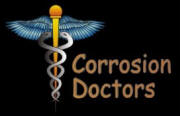Announcement
Collapse
No announcement yet.
cleaning electrical connections
Collapse
X
-
cleaning electrical connections
Got some good tips off cliff's source. Have no idea were to purchase hydrofluoric acid, and how will it affect the hard-shell connectors. any tips? thanks again.Tags: None
-
Forum LongTimerBard Award Winner
GSResource Superstar
Past Site Supporter- Jul 2005
- 15154
- Marysville, Michigan
It also looks like its used to etch tooth enamel and to etch concrete.Hydrofluoric (HF) acid is used mainly for industrial purposes (e.g. glass etching, metal cleaning, electronics manufacturing). HF acid also may be found in home rust removers.
 SaverSystems is the home of ChimneySaver, HeatShield & PriorFire fireplace, chimney and masonry products. From chimney repair to waterproofing solutions, we have the tools & expertise to keep your home safe and protected. Browse our selection of products and find the perfect solution for your chimney maintenance needs.
SaverSystems is the home of ChimneySaver, HeatShield & PriorFire fireplace, chimney and masonry products. From chimney repair to waterproofing solutions, we have the tools & expertise to keep your home safe and protected. Browse our selection of products and find the perfect solution for your chimney maintenance needs.
Rust remover. http://www.baneclene.com/catalog/whi...t_remover.html
Bumble around and you should be able to come up with something...Last edited by rustybronco; 04-09-2013, 10:45 PM.
-
Hydrofluoric acid is extremely dangerous, as RB's link says. Do not use it unless you are a chemist and have special training in its use, from a person who has experience in the use of HF and other highly toxic chemicals. Note that the link to health risks says that the product is only for professional use, not for consumers.
Other kinds of contact cleaners can be used. All electronics supply stores carry them. Builders' supply stores such as Lowe's and Home Depot carry them. We've had several threads on them. De-Ox-It has a following. It can be bought from Fryes.
Small brushes can also be used to remove corrosion. While I've not used them, i've been told that brass brushes for cleaning barrells of 22s and smaller work well.
The chance that there is corrosion and at the interface between copper wire and brass or aluminum connectors is significant on bikes the age of ours. If the above methods don't work, it seems better to me to remove the connecters and replace them. We've had many threads on that, too. The consensus among those who seem to know the most is to crimp and solder.sigpic[Tom]
“The greatest service this country could render the rest of the world would be to put its own house in order and to make of American civilization an example of decency, humanity, and societal success from which others could derive whatever they might find useful to their own purposes.” George Kennan
Comment
-
 still_bluenoser
still_bluenoser
Contact cleaner with an acid brush. Depending on the location I than give it a spray with ACF50 or I coat lightly with electrical insulating compound. It will not interfere with a physical connection, and will reduce further corrosion later. If its in a dirty location I use ACF50 as it doesn't hold dirt like the insulating compound does.
A properly cleaned connector will give you no troubles. Its the neglected ones that give resistance (heat) and fail giving folks the idea to remove the connector in favor of a solid connection.
Comment
-
 smoothbored
smoothbored
still looking.
Using Spray contact cleaner on a brass bullet type connector with a clear plastic cover will not clean a green/corroded metal. check bass cliff's harness cleaning pictures. what ever they used made the brass look like brand new.
Comment
-
 mike_of_bbg
mike_of_bbg
Yes, you need an acid to reverse chemical corrosion. Contact cleaners just won't do it. I've had good success with Naval Jelly, the rust removal stuff you can get at almost any hardware store. My multi-step process (wear proper protection, particularly eye protection for steps 2-3):
1) If the contacts are actually dirty, clean them first. Brake cleaner works well.
2) Dunk a few brass connectors at a time in a baby-food or similar glass jar full of Naval Jelly. Soak them for at least 10-15 minutes.
3) Vigorously rinse in warm water to remove all of the naval jelly. If you can't get all the Naval Jelly out, shoot it with some brake cleaner.
4) Spray with WD-40 to displace the water.
5) Spray with brake cleaner.
6) Coat with dielectric Silicone compound before re-assembly.
Comment
-
agree with all except...............Once the crimps are clean I would flow solder into them (but then that is just meOriginally posted by mike_of_bbg View PostYes, you need an acid to reverse chemical corrosion. Contact cleaners just won't do it. I've had good success with Naval Jelly, the rust removal stuff you can get at almost any hardware store. My multi-step process (wear proper protection, particularly eye protection for steps 2-3):
1) If the contacts are actually dirty, clean them first. Brake cleaner works well.
2) Dunk a few brass connectors at a time in a baby-food or similar glass jar full of Naval Jelly. Soak them for at least 10-15 minutes.
3) Vigorously rinse in warm water to remove all of the naval jelly. If you can't get all the Naval Jelly out, shoot it with some brake cleaner.
4) Spray with WD-40 to displace the water.
5) Spray with brake cleaner.
6) Coat with dielectric Silicone compound before re-assembly. )
)
Comment
-
 GS(X)400
GS(X)400
In Canada and I assume the states there is a product called CLR. Thats it a light acid that works for cleaning contacts. Just dip them in some of the product for 20 seconds rinse with break clean or contact cleaner to remove the residue. Safe for plastic as well. You can just repeat as needed just dont keep it dipped for to long
Comment
-
 GS(X)400
GS(X)400
It was a while ago when i used it for this. Well crap looks like there is no effective de-oxidising products avalible in canada anymore. I need to come up with a new plan for my harnes cleaning
Comment
-
 GS(X)400
GS(X)400 -
 GateKeeper
GateKeeper
here is a placeOriginally posted by GS(X)400 View PostThat stuff hard to find out my way.
and use their search button....
A&A electronics in mississauga and victoria park,
sayal in mississauga and victoria park
just a few places
but I don't know where in Canada you are....but they might ship...
.
Comment
-
 Wizard
Wizard
Clr
Use CLR, stuff is cheap, easy to find and not too nasty.
Use it 100% strength, and use a small soft brush, just takes a few minutes.
Rinse well with water. Let it dry in the sun.
Then use Flux & Solder and flow the crimp.

Crimp the pinchers a little, then Spritz with WD40, good to go.
This should last a while, unless you ride in the rain and/or store bike in a bad location, in which case you'll need Clean/Pinch/Spritz more often.Last edited by Guest; 06-03-2013, 03:40 PM.
Comment
-
Those are prettyOriginally posted by Wizard View PostUse CLR, stuff is cheap, easy to find and not too nasty.
Use it 100% strength, and use a small soft brush, just takes a few minutes.
Rinse well with water. Let it dry in the sun.
Then use Flux & Solder and flow the crimp.

Crimp the pinchers a little, then Spritz with WD40, good to go.
This should last a while, unless you ride in the rain and/or store bike in a bad location, in which case you'll need to do this more often. Nice solder work as well
Nice solder work as well
Comment
.png)




Comment